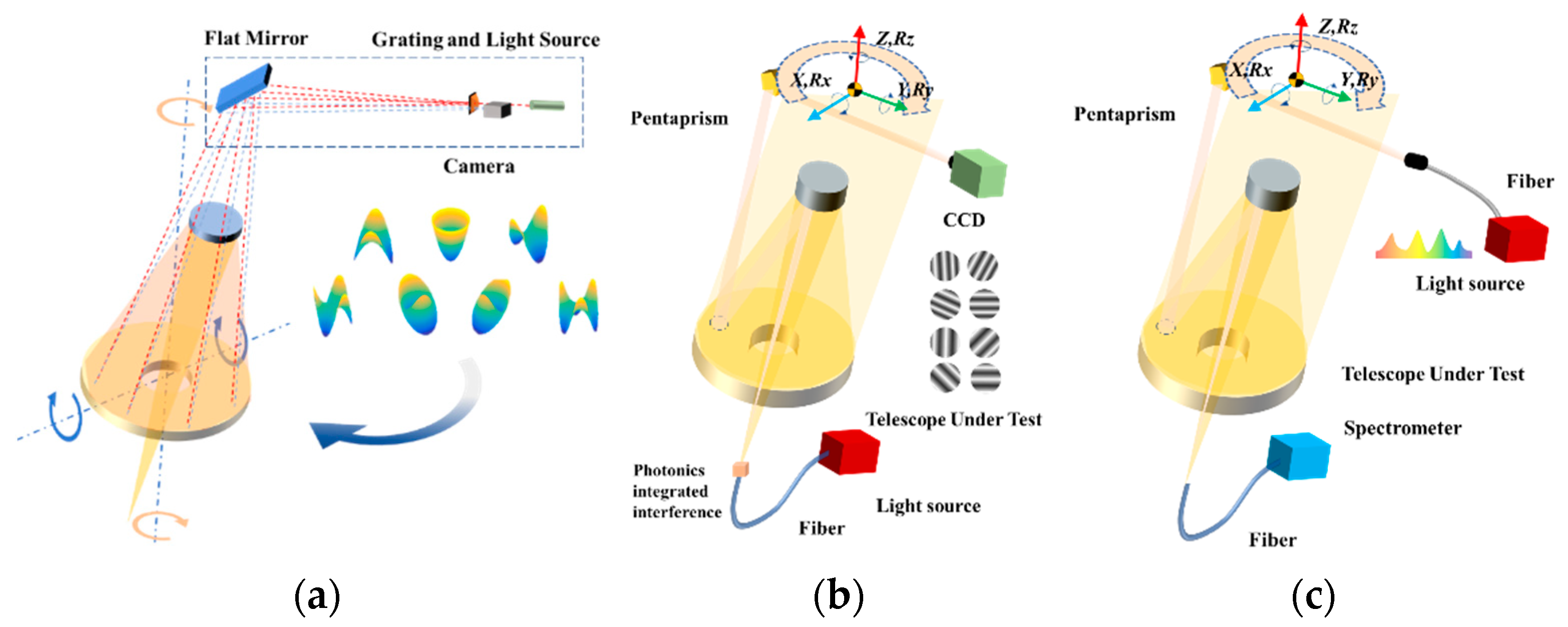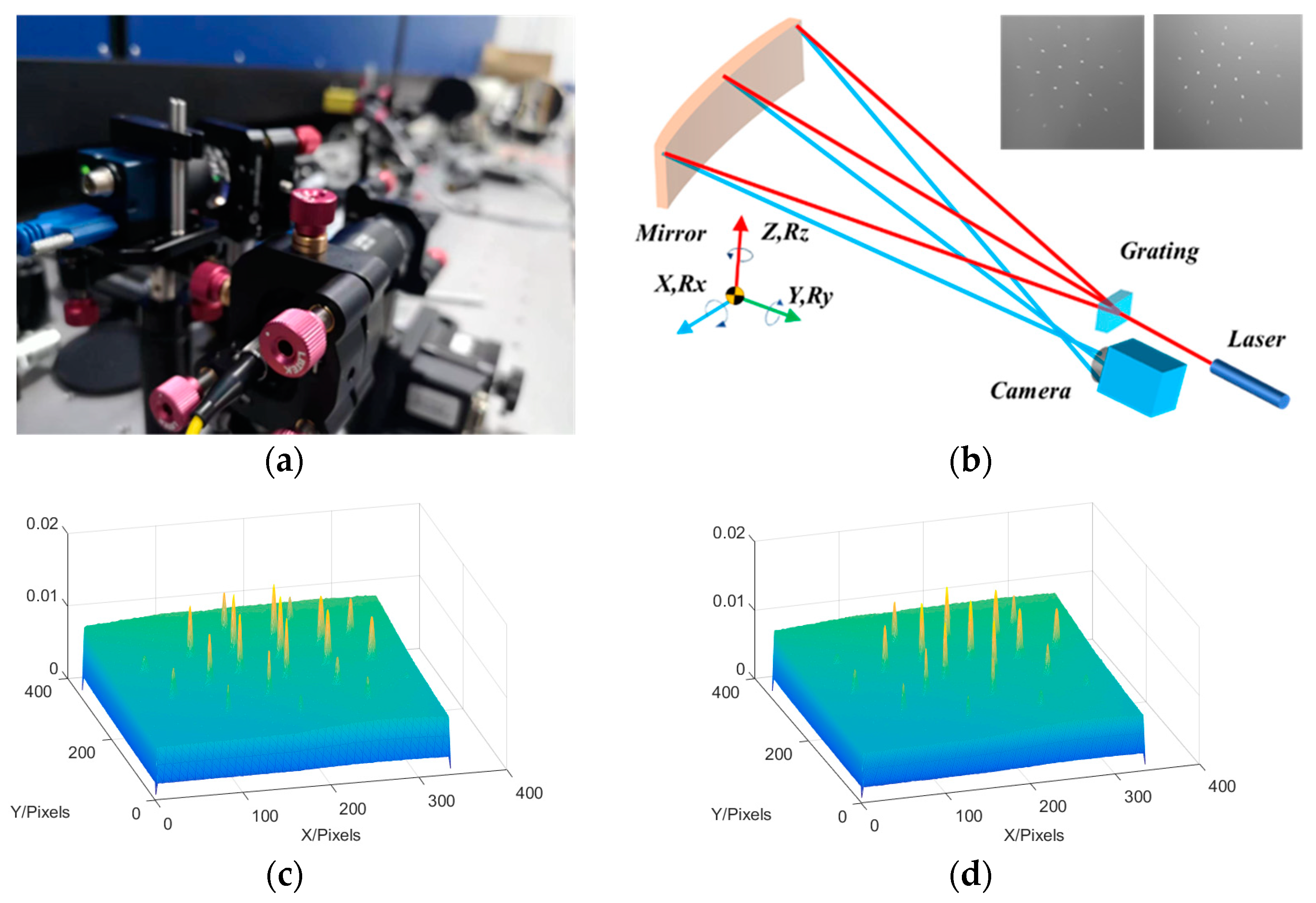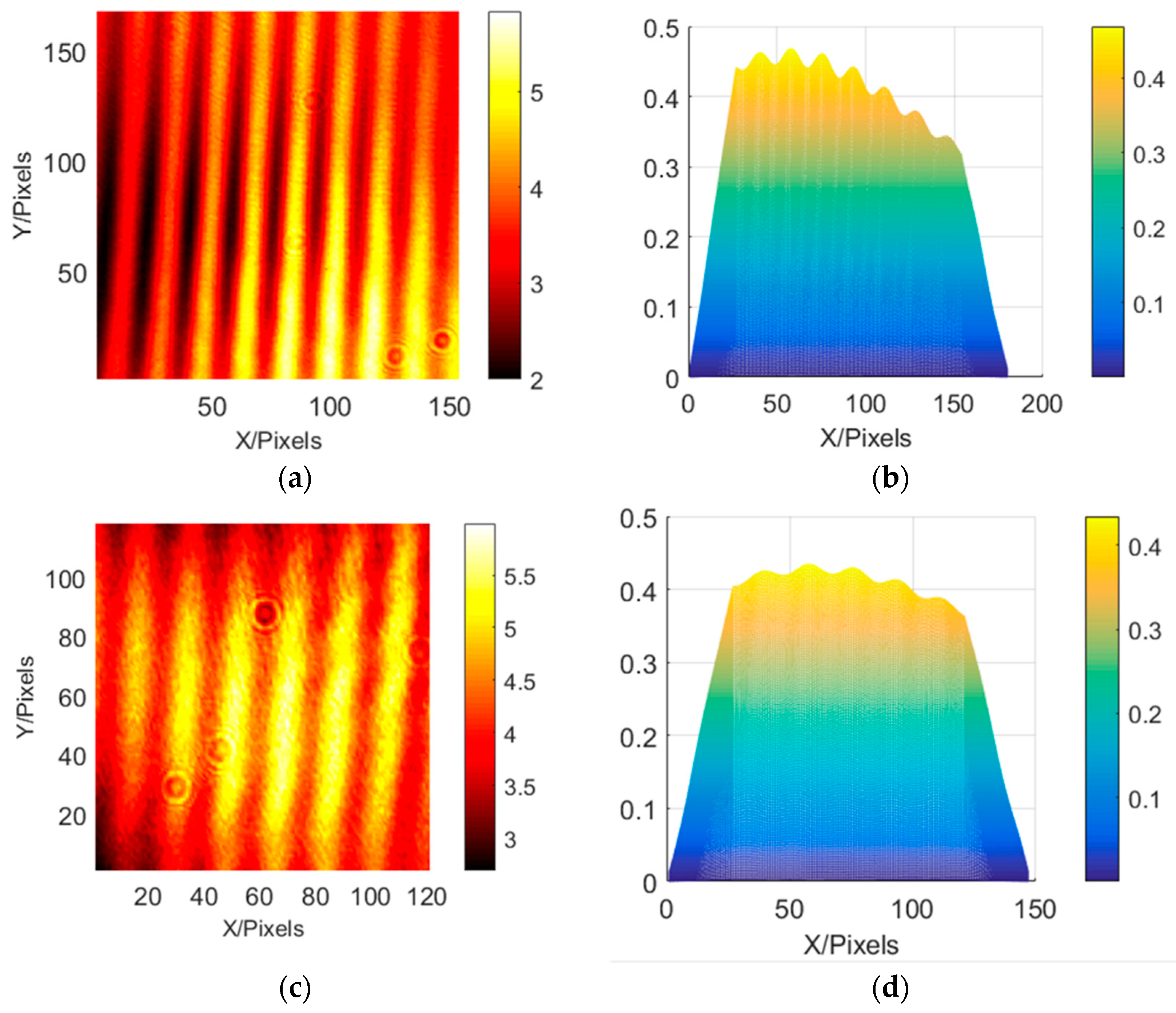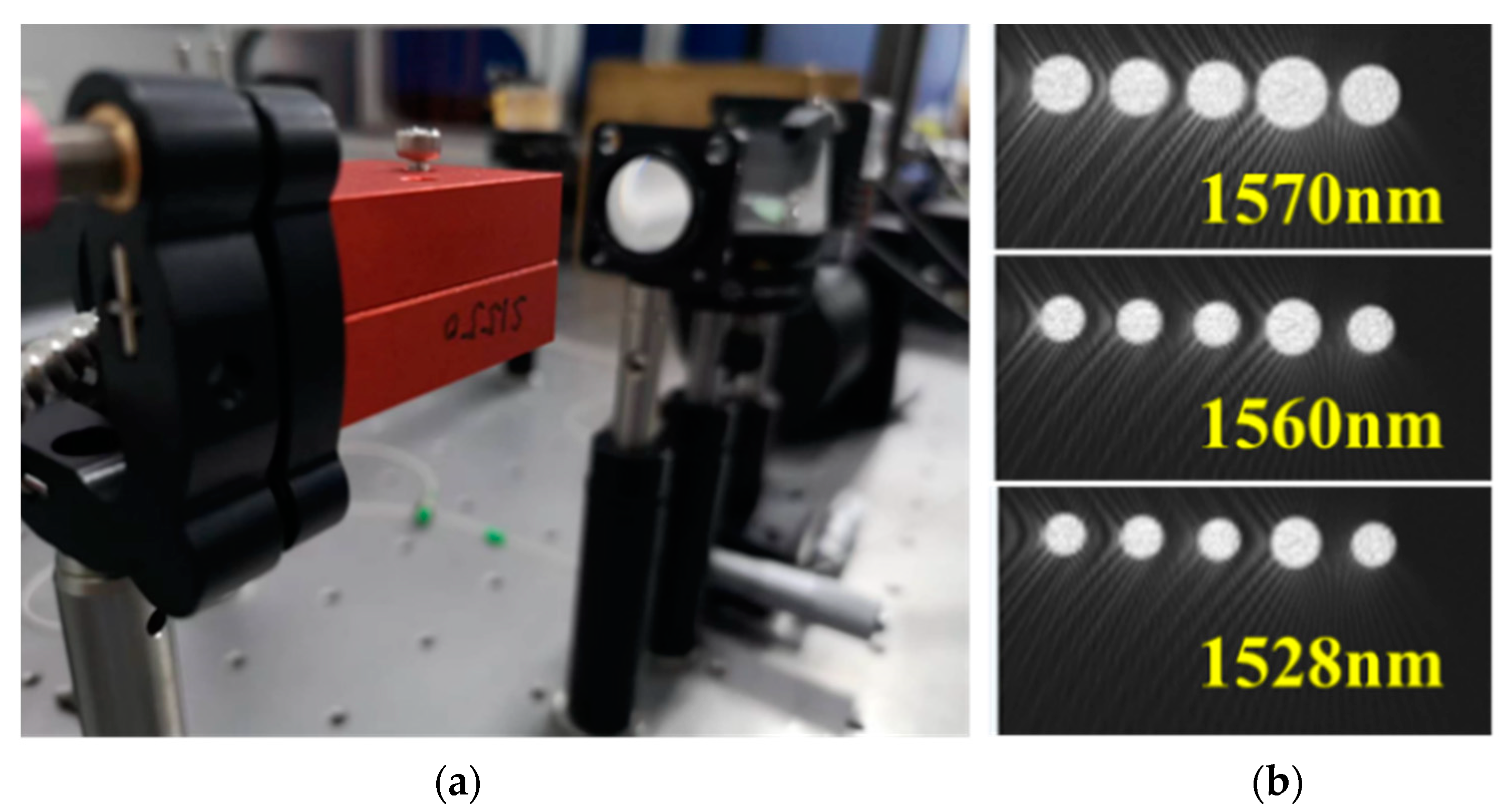Photonics Scanning Pentaprism System for the Integrated Inspection of Large-Aperture Telescopes
Abstract
1. Introduction
2. Materials and Methods
2.1. Measurement Architecture and Methods
2.2. Basic Principles of Wavefront Detection and Spectral Detection
3. Simulation Results
4. Experimental Verification
4.1. System Benchmark Establishment and Measurement
4.2. System Wavefront Measurement
4.3. System Spectral Response Measurement
5. Discussion
6. Conclusions
Author Contributions
Funding
Institutional Review Board Statement
Informed Consent Statement
Data Availability Statement
Conflicts of Interest
References
- Chen, S.; Xue, S.; Wang, G.; Tian, Y. Subaperture stitching algorithms: A comparison. Opt. Commun. 2017, 390, 61–71. [Google Scholar] [CrossRef]
- Borota, S.A.; Li, L.; Cuzner, G.; Hutchison, S.B.; Cochrane, A. Atmospheric optical turbulence measurements in the LOTIS vacuum chamber and LOTIS collimator jitter analysis results. SPIE 2009, 7330, 7330003. [Google Scholar]
- Bell, R.; Hutchinson, S.B.; Borota, S. LOTIS facility successfully reaches initial operation capability. In Proceedings of the International Conference on Space Optics, Rhodes Island, Greece, 5 September 2010; Volume 10565, pp. 794–800. [Google Scholar]
- West, S.C.; Bailey, S.H.; Burge, J.H.; Cuerden, B.; Tuell, M.T. Wavefront control of the large optics test and integration site (lotis) 65 m collimator. Appl. Opt. 2010, 49, 3522–3537. [Google Scholar] [CrossRef]
- Wen, Z.; Zhang, Q.; Li, S.; Lei, W.; Du, G. Multi-optical axis parallelism calibration of space photoelectric tracking and aiming system. Chin. Opt. 2021, 14, 625–633. [Google Scholar] [CrossRef]
- Xu, D.H.; Tang, X.H.; Fang, G.M.; Wu, D.D.; Zhou, H.R. Method for calibration of optical axis parallelism based on interference fringes. Acta Opt. Sin. 2020, 40, 1712005. (In Chinese) [Google Scholar]
- Yi, Z.; Wang, L.S.; Yang, J.C.; Luo, T.F.; Prophet, S. Design of parallelism of optical axis in-situ detection’s optical system of observing and aiming system. Opt. Tech. 2018, 44, 113–116. (In Chinese) [Google Scholar]
- Katrašnik, J.; Bürmen, M.; Pernuš, F.; Likar, B. Spectral characterization and calibration of AOTF spectrometers and hyper-spectral imaging systems. Chemom. Intell. Lab. Syst. 2010, 101, 23–29. [Google Scholar] [CrossRef]
- Aab, A.; Abreu, P.; Aglietta, M.; Al Samarai, I.; Albuquerque, I.; Allekotte, I.; Almela, A.; Castillo, J.A.; Alvarez-Muñiz, J.; Anastasi, G.; et al. Spectral calibration of the fluorescence telescopes of the Pierre Auger Observatory. Astropart. Phys. 2017, 95, 44–56. [Google Scholar] [CrossRef]
- Dorner, B.; Giardino, G.; Ferruit, P.; De Oliveira, C.A.; Birkmann, S.M.; Böker, T.; De Marchi, G.; Gnata, X.; Köhler, J.; Sirianni, M.; et al. A model-based approach to the spatial and spectral calibration of NIRSpec onboard JWST. Astron. Astrophys. 2016, 592, A113. [Google Scholar] [CrossRef]
- Fulton, T.; Hopwood, R.; Baluteau, J.-P.; Benielli, D.; Imhof, P.; Lim, T.; Lu, N.; Marchili, N.; Naylor, D.; Polehampton, E.; et al. Herschel SPIRE FTS relative spectral response calibration. Exp. Astron. 2014, 37, 381–395. [Google Scholar] [CrossRef]
- Barrelet, E.; Juramy, C. Direct illumination LED calibration for telescope photometry. Nucl. Instrum. Methods Phys. Res. Sect. A 2008, 585, 93–101. [Google Scholar] [CrossRef][Green Version]
- Fratz, M.; Seyler, T.; Bertz, A.; Carl, D. Digital holography in production: An overview. Light Adv. Manuf. 2021, 2, 15. [Google Scholar] [CrossRef]
- Chkhalo, N.I.; Malyshev, I.V.; Pestov, A.; Polkovnikov, V.N.; Salashchenko, N.N.; Toropov, M.N.; Vdovichev, S.N.; Strulya, I.L.; Plastinin, Y.A.; Rizvanov, A. Collimator based on a Schmidt camera mirror design and its application to the study of the wide-angle UV and VUV telescope. J. Astron. Telesc. Instrum. Syst. 2018, 4, 014003. [Google Scholar] [CrossRef]
- Burke, D.L. Photometric Calibration of LSST Data. In The 2007 ESO Instrument Calibration Workshop; Kaufer, A., Kerber, F., Eds.; ESO Astrophysics Symposia European Southern Observatory; Springer: Berlin/Heidelberg, Germany, 2008. [Google Scholar] [CrossRef]
- Clark, P.; Berry, P.; Bingham, R.G.; Bissonauth, N.; Caldwell, M.; Dipper, N.A. Wavefront Sensing within the VISTA Infrared Camera. In Proceedings of the SPIE—The International Society for Optical Engineering, Glasgow, UK, 29 September 2004; Volume 5499, pp. 379–386. [Google Scholar]
- Ekinci, M.; Selimoğlu, Ö. Development of a 0.5 m clear aperture Cassegrain type collimator telescope. SPIE 2016, 9912, 991253. [Google Scholar]
- An, Q.; Zhang, H.; Wu, X.; Wang, J.; Chen, T.; Ju, G. Curvature sensing-based pupil alignment method for large-aperture telescopes. IEEE Photon. J. 2023, 15, 6800705. [Google Scholar] [CrossRef]
- Wei, H.S.; Yan, F.; Chen, X.D.; Zhang, H.; Cheng, Q.; Xue, D.L.; Zeng, X.F.; Zhang, X.J. Large-aperture space optical system testing based on the scanning Hartmann. Appl. Opt. 2017, 56, 2078–2083. [Google Scholar] [CrossRef] [PubMed]
- Zepp, A.; Gladysz, S.; Stein, K.; Osten, W. Simulation-based design optimization of the holographic wavefront sensor in closed-loop adaptive optics. Light Adv. Manuf. 2021, 60, F88–F98. [Google Scholar] [CrossRef]
- Barber, S.K.; Geckeler, R.D.; Yashchuk, V.V.; Gubarev, M.V.; Buchheim, J.; Siewert, F. Optimal alignment of mirror based pentaprisms for scanning deflectometric devices. Opt. Eng. 2011, 50, 073602. [Google Scholar] [CrossRef]
- Lacey, I.; Geckler, R.D.; Just, A.; Siewert, F.; Arnold, T.; Paetzelt, H. Optimization of the size and shape of the scanning aperture in autocollimator-based deflectometric profilometers. Rev. Sci. Instrum. 2019, 90, 021717. [Google Scholar] [CrossRef] [PubMed]
- Sirohi, R. Shearography and its applications—A chronological review. Light Adv. Manuf. 2022, 3, 35–64. [Google Scholar] [CrossRef]










Disclaimer/Publisher’s Note: The statements, opinions and data contained in all publications are solely those of the individual author(s) and contributor(s) and not of MDPI and/or the editor(s). MDPI and/or the editor(s) disclaim responsibility for any injury to people or property resulting from any ideas, methods, instructions or products referred to in the content. |
© 2023 by the authors. Licensee MDPI, Basel, Switzerland. This article is an open access article distributed under the terms and conditions of the Creative Commons Attribution (CC BY) license (https://creativecommons.org/licenses/by/4.0/).
Share and Cite
An, Q.; Zhang, H.; Wang, K.; Liu, X.; Li, H. Photonics Scanning Pentaprism System for the Integrated Inspection of Large-Aperture Telescopes. Sensors 2023, 23, 6650. https://doi.org/10.3390/s23156650
An Q, Zhang H, Wang K, Liu X, Li H. Photonics Scanning Pentaprism System for the Integrated Inspection of Large-Aperture Telescopes. Sensors. 2023; 23(15):6650. https://doi.org/10.3390/s23156650
Chicago/Turabian StyleAn, Qichang, Hanfu Zhang, Kun Wang, Xinyue Liu, and Hongwen Li. 2023. "Photonics Scanning Pentaprism System for the Integrated Inspection of Large-Aperture Telescopes" Sensors 23, no. 15: 6650. https://doi.org/10.3390/s23156650
APA StyleAn, Q., Zhang, H., Wang, K., Liu, X., & Li, H. (2023). Photonics Scanning Pentaprism System for the Integrated Inspection of Large-Aperture Telescopes. Sensors, 23(15), 6650. https://doi.org/10.3390/s23156650





